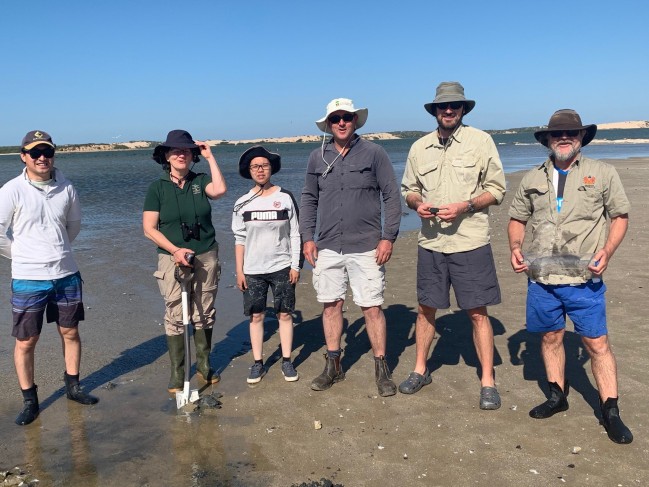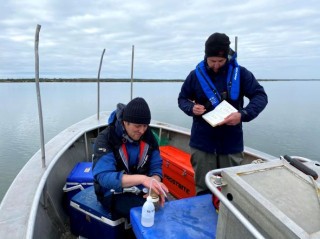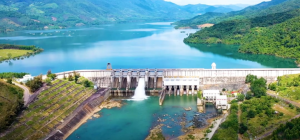
Nutrients are known to be a key driver of aquatic ecosystem health. While nutrients are essential for all living organisms, high nutrient levels can lead to problems such as excessive algal growth, or ‘algal blooms’. Ongoing research by the Goyder Institute has identified that this is the case for the Coorong South Lagoon; the knowledge generated through this important research is being used to support decisions for managing nutrient levels and the health of the system.
In our June issue of our eNews, we highlighted that the Goyder Institute-led components of the $77.8 million Healthy Coorong, Healthy Basin (HCHB) program had reached its half-way point. This initiative of the Australian and South Australian governments aims to support the long-term health of the Coorong by providing evidence-based solutions to both immediate threats and future conditions under a changing climate. The Coorong is an area of immense environmental, cultural and social value to South Australia and Australia.
Over the coming months, we will present a series of In Focus snapshots on each of the five research projects being led by the Goyder Institute in collaboration with our partners: the Commonwealth Scientific and Industrial Research Organisation (CSIRO), Department for Environment and Water, Flinders University, the University of Adelaide and the University of South Australia.
This month, we focus on the nutrient dynamics of the Coorong South Lagoon led by Associate Professor Luke Mosley and team at the University of Adelaide and involving other leading researchers from across Australia including the University of South Australia, Flinders University, CSIRO, Griffith University, and Southern Cross University. This rigorous science is providing a knowledge base to be applied to existing and new management interventions to reduce nutrient availability and conditions that promote excessive filamentous algal growth in the Coorong. The data and knowledge generated will improve and validate biogeochemical models that are critical to support evidence-based decisions on flow management and infrastructure options.
The research undertaken by Dr Mosley’s team over the past year has led to some significant insights into the nutrient dynamics of the Coorong system and especially within the Coorong South Lagoon.
Dr Mosley said “Nutrients such as nitrogen and phosphorus have always been a key driver of the ecology of the Coorong. Over the past two decades, we have seen a switch in ecological states of the Coorong South Lagoon from being dominated by aquatic plants such as Ruppia, to being dominated by filamentous algae and phytoplankton. While water levels and salinity levels have played their part in this change, our research over the past year has shown that nutrients are also playing a critical role in the condition of the Coorong South Lagoon.”
Prior to the HCHB Nutrient Dynamics research program, key knowledge gaps existed regarding the influence of flows from the River Murray and from the South East via Salt Creek on importing nutrients into the system, and flushing nutrients out of the South Lagoon.
“What we are finding is that the majority of nutrients are being imported into the Coorong from October to March via the River Murray and Lower Lakes, as well as the Southern Ocean, and then exported from April to September” Dr Mosley said. “This reflects seasonal patterns linked to River Murray inflows (and thus rainfall and climate in the Murray-Darling Basin), and coastal ocean conditions. In comparison, flows from the South East via Salt Creek contribute only a fraction of the nutrients, however, the influence of this localised input is magnified in the South Lagoon.”
It was also previously unknown whether the South Lagoon sediments, particularly in the deeper channels of the lagoon, are acting as nutrient sources or are a repository for nutrients; and what the pathways are for nutrient cycling.
“Our research is showing that the sediment quality and nutrient cycling processes in the South Lagoon are currently in an unhealthy state” said Dr Mosley. “There are approximately 50 times more nutrients in the top 5 cm of sediment compared to the whole water column in the Coorong. This has significant implications for the future management of nutrients to help return the system to an aquatic plant dominated state. Our investigations are showing that improving the flushing of the South Lagoon would help reduce nutrient levels in the water and sediment, and also salinity.”

The current conditions that are impacting the condition and resilience of the aquatic plant Ruppia and even the presence of macroinvertebrate communities in the South Lagoon also has implications for the health of the sediments.
“Anoxic sediments have little or no oxygen in them, and they are present throughout the Coorong South Lagoon. The roots of Ruppia release oxygen into the sediment when they can gather enough light and photosynthesise. This oxygen release supports nutrient cycling and enhances sediment health by reducing the amount of oxygen deprived (anoxic) sediment” said Dr Mosley. “In addition, macroinvertebrates can help introduce oxygen into the sediment when they burrow. Re-establishing more populations of Ruppia and macroinvertebrates in the South Lagoon will assist in reducing sediment and water column nutrient concentrations.”
The next year of research being undertaken by the Goyder Institute team will further investigate the complexities of biogeochemical interactions within and between the sediment and water column, as well as further examining the potential for nutrient removal options to improve the health of the system.
More information on the HCHB nutrient dynamics research can be found here, and the HCHB synthesis report on nutrients in the Coorong can be found here. For further information on the Goyder Institute-led HCHB research, please contact Dr Alec Rolston.


